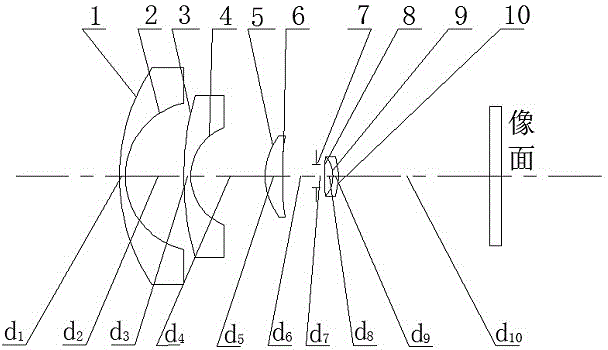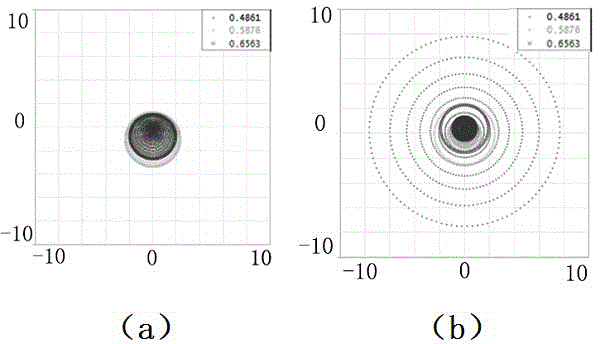Super-large field-of-view fish eye lens
A field of view fish and eye lens technology, applied in the field of optical wide-angle lens and optical lens, can solve the problems of poor imaging quality, large number of lenses, complex optical system, etc.
- Summary
- Abstract
- Description
- Claims
- Application Information
AI Technical Summary
Problems solved by technology
Method used
Image
Examples
Embodiment 1
[0038] In this example, see Figure 1-8 and Figure 10, a super large field of view fisheye lens, characterized in that the optical system is a structure of 5 elements in 4 groups, arranged from left to right along the common central axis of the lenses, and the composition of the lenses is: the first group with negative diopter The lens and the second group of lenses with positive diopter, the first group of lenses are composed of the first negative lens and the second negative lens arranged in sequence from the left object side to the right image side, the second group of lenses is composed of the first negative lens Three positive lenses, the fourth positive lens and the fifth negative lens are composed of three lenses arranged in sequence from left to right. The mirror surface facing the object plane of the fifth negative lens is the first front mirror surface 1, the second front mirror surface 3, the third front mirror surface 5, the fourth front mirror surface 8 and the ...
Embodiment 2
[0054] This embodiment is basically the same as Embodiment 1, the difference is:
[0055] In this example, see Figure 1-9 And following table 2, the aspheric coefficient of the first front mirror surface 1 towards the first negative lens of the object plane is-0.44, and the aspheric coefficient of the second front mirror surface 3 of the second negative lens towards the object plane is- 0.89, the first rear mirror surface 2 of the first negative lens facing the image plane, the second rear mirror surface 4 of the second negative lens facing the image plane, and the mirror surfaces of other lenses are all spherical. The overall structural parameters of the super large field of view fisheye lens optical system are set as follows:
[0056] The total focal length of the optical system is: EFL=14.64;
[0057] Total length of optical system: L=96.40;
[0058] Full field of view: 0°≤2ω≤180°;
[0059] Dominant wavelength: 0.58756;
[0060] Back focal length: l F =36.92;
[006...
PUM
| Property | Measurement | Unit |
|---|---|---|
| Full field of view | aaaaa | aaaaa |
Abstract
Description
Claims
Application Information
 Login to View More
Login to View More - R&D
- Intellectual Property
- Life Sciences
- Materials
- Tech Scout
- Unparalleled Data Quality
- Higher Quality Content
- 60% Fewer Hallucinations
Browse by: Latest US Patents, China's latest patents, Technical Efficacy Thesaurus, Application Domain, Technology Topic, Popular Technical Reports.
© 2025 PatSnap. All rights reserved.Legal|Privacy policy|Modern Slavery Act Transparency Statement|Sitemap|About US| Contact US: help@patsnap.com



